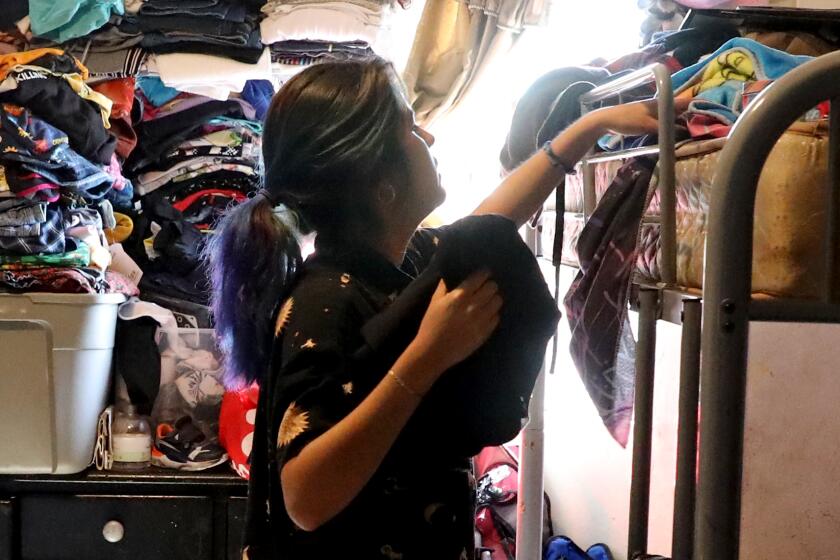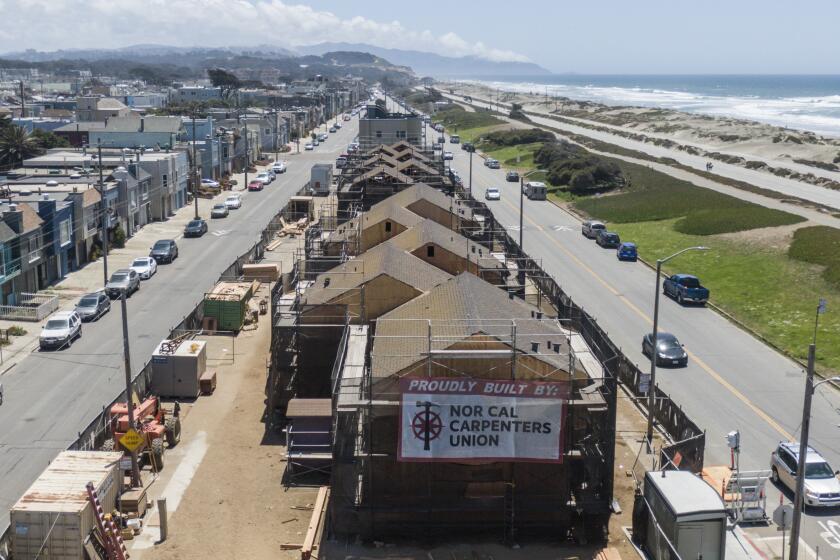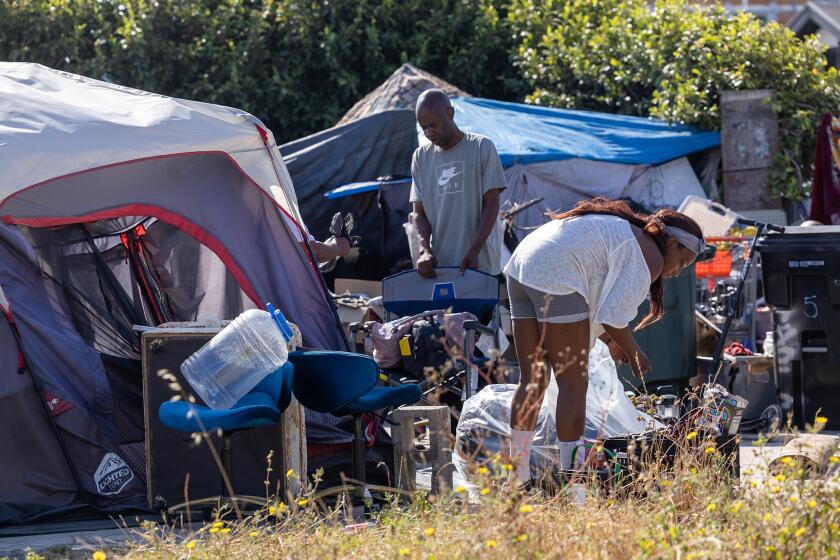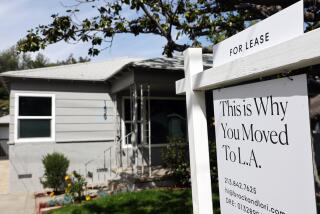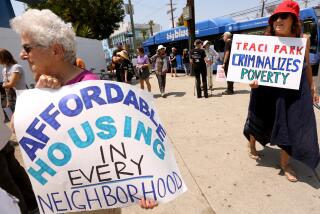Los Angeles’ $22-billion homelessness problem gives leaders a choice: Double down or change strategies

- Share via
- It would cost $21.7 billion to end homelessness in a decade in Los Angeles, two-thirds of which is unfunded, according to a new city report.
- Experts interviewed by The Times were split between some who said the report presents a realistic picture of costs and others who argued it revealed a need for less expensive strategies.
City of Los Angeles officials are finally confronting a question that has seemed too big to answer: How much would it actually cost to get every person living on the street today indoors and make sure that no one languished there for years again?
The answer, in a report now circulating through City Hall, is a whopper: $21.7 billion over a decade. And since less than $7 billion of that sum is budgeted, local, state and federal governments would have to pony up three times what they’re planning.
The report presents a stark and sobering picture of how far the city is from solving its most pressing problem, according to homelessness experts who reviewed the report at The Times’ request. It leaves Mayor Karen Bass and other city officials with three paths, they said: Drastically ramp up existing programs and convince elected leaders and voters to fund that $21.7 billion, change course to less expensive programs or continue muddling through in the hopes that larger economic, political and real estate forces improve the housing situation.
Though the experts commended the report for attempting to grapple holistically with an intractable issue, some thought its focus on government subsidies failed to account for the primary cause of homelessness: an inadequate supply of affordable housing in the marketplace.
Margot Kushel, a professor of medicine at UC San Francisco and director of the school’s Benioff Homelessness and Housing Initiative, said that the figures in the report represent a realistic accounting of what’s required to counteract decades of starved funding for low-income housing and social services.
“In some ways, it’s an eye-popping dollar amount,” Kushel said. “In other ways, it doesn’t seem that eye-popping to me for the scale of the problem.”
But Dennis Culhane, a professor of social policy at the University of Pennsylvania who has researched homelessness in L.A., said the report reveals the failures of the city’s current strategies. They’re too expensive, he said, to meet the vast needs on the streets.
The city should shift its focus, he said, from supportive housing construction to giving homeless and at-risk Angelenos money to help pay their rent on the private market.
“In the existing approach, part of the problem is it isn’t scalable,” Culhane said. “We need to think about approaches that would be.”
It’s unclear how much Bass and other leaders plan to rely on the report, which was authored by the city’s housing department. Bass officials previously deflected questions on a draft analysis The Times published last month and did not respond to a request for comment on the final version. City Councilmember Nithya Raman said she hoped it would guide spending decisions and funding requests to state and federal officials. She plans to discuss the report next month in the housing and homelessness committee she chairs.
Homelessness spending in Los Angeles must more than double to $2 billion a year to end sleeping on the streets in the city, according to a draft report by housing officials
There are about 45,000 people who are homeless in the city of Los Angeles, 29,000 of whom are unsheltered, according to the most recent point-in-time count of the homeless population.
The housing department analysis assumes additional people will become homeless over time. Even with that assumption, executing the plan would decrease the overall homeless population until the city reached what’s known as “functional zero” at the end of 2032, the department wrote. That means episodes of homelessness would be rare and brief and anyone who needed a shelter bed could access one.
If funded, the proposal would lead to construction or subsidy of nearly 60,000 units of homeless housing, including 19,500 in new supportive housing developments, 12,500 through a rental assistance program and 9,200 beds in facilities providing higher levels of care for elderly and severely mentally ill residents. Additionally, the city would offer as many as 20,000 beds in homeless shelters, before ramping down the number as more permanent housing is built.
The final version of the report has a higher price tag than the draft The Times published last month, primarily due to the addition of the higher level of care facilities, which officials say are needed for a population that’s increasingly infirm. The funding gap has risen to $15.4 billion — an amount larger than the city’s entire annual budget.
While the numbers are big, Kushel said she can’t imagine a scenario where the necessary total is much lower given the historic lack of support for housing programs in L.A. and across the country.
More homes are overcrowded in L.A. than in any other large U.S. county, a Times analysis of census data found — a situation that has endured for three decades.
“This is the hole we’ve found ourselves in,” she said. “I don’t think there’s magical thinking that’s going to get us out of it.”
She fears the alternative to deeper investment in housing would be punitive measures criminalizing sleeping on the streets, especially in the wake of this summer’s U.S. Supreme Court ruling allowing cities to more aggressively clear encampments. Those efforts can end up costlier than building supportive housing, which research shows is effective in solving homelessness among those with poor physical and mental health and substance use disorders, she said.
“I would rather live in a place that spent its money on allowing people to live in community with choice and autonomy over their lives,” Kushel said. “We seem to have an unending appetite to spend money on carceral settings.”
Others believe that the city report reveals that the current system for combating homelessness is broken, most notably the process for financing new construction.
To build the supportive housing called for in the report through existing models, the federal and state governments would need to triple the capital allocation they plan to provide, an amount that makes up nearly a third of the overall funding gap. The city also would need to receive 22 times the annual amount of federal housing vouchers it gets now to cover operations in the new buildings.
“It seems like a little bit of a nonstarter in terms of reality,” said Jason Ward, an economist and co-director of the Rand Center on Housing and Homelessness.
Ward said it’s likely the price tag undercounts the true cost as well. His research indicates that supportive housing projects funded with construction union labor and other mandates cost about $100,000 more per unit than what the housing department is estimating.
A better strategy, he said, would be to blow up the funding apparatus in exchange for one that gave developers grants with firm timelines and cost and affordability requirements but allowed flexibility in construction and financing methods to meet them.
“All this stuff in this report is predicated on these status quo mechanisms that are just very inefficient and costly and slow,” Ward said.
At least seven low-income housing developments funded by the state have eclipsed more than $1 million per apartment to build in the last two years.
Culhane, the University of Pennsylvania researcher, said the report shows the need to prioritize rental subsidies over building.
Yes, he said, there’s a shortage of housing. But he argued rental assistance would be less expensive, put more money directly into the hands of people who need it and lessen administrative costs and burdens.
“There is a public appetite for effective solutions that can show real progress,” Culhane said. “That means it has to be done more quickly than happens under a new construction situation.”
Raman has said she’s encouraged by data showing higher than expected success rates from a regional subsidy program that helps pay rent for homeless people for up to two years. An expansion of that effort, she said, could lower costs compared to new building.
Raman said she’s still reviewing the report’s conclusions, but at a minimum predicted it would help unify all levels of government behind common spending and strategies to address homelessness. Public officials and civic leaders are working on a similar analysis for all of L.A. County.
“Ultimately what this report is saying is not that controversial,” Raman said. “The scale of the numbers is. It’s saying the more you invest in housing and shelter the lower the number of people who are on the streets of Los Angeles.”
The 2024 homeless count found the number of people living on Los Angeles city and county streets declined after five years of increases.
One of the biggest criticisms of the report centers on what it didn’t include. Research shows that the most significant predictor of homelessness is the overall cost and availability of rental housing.
By leaving out a discussion of ways to loosen the housing market for tenants, the report misses a crucial, and largely unsubsidized, element to limit the flow of people into homelessness, Ward said.
Recent action is discouraging in that regard, he said. City officials are recommending a continuation of an apartment construction ban in areas zoned for single-family homes, nearly three-quarters of L.A.’s residential land. Additionally, a Bass-led affordable housing streamlining program known as Executive Directive 1 initially saw massive interest from for-profit developers to build apartments reserved for low-income tenants. But subsequent iterations of the program have curtailed the benefits and lessened its use.
“Leadership in L.A., someone is going to have to fall on a big, fat grenade to really change the way housing is produced,” Ward said.
More to Read
Sign up for Essential California
The most important California stories and recommendations in your inbox every morning.
You may occasionally receive promotional content from the Los Angeles Times.

